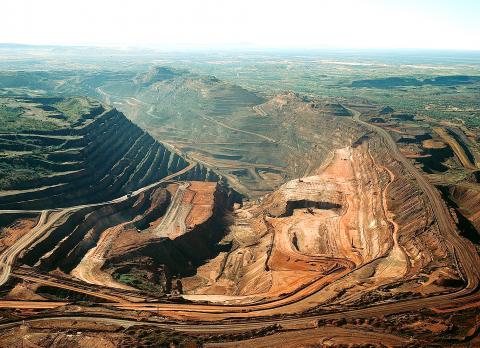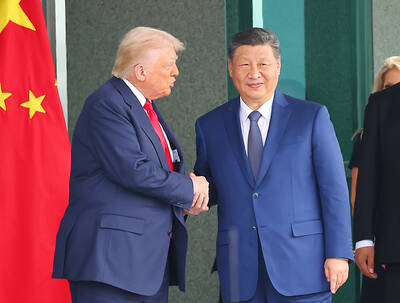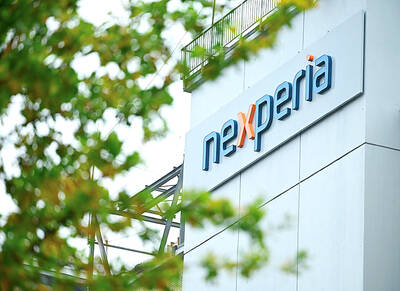A Chinese private equity firm yesterday announced a hostile takeover bid for Australia-listed Discovery Metals, valuing the copper miner at A$830 million (US$857 million), Discovery said.
Shanghai-based Cathay Fortune Corp (CFC, 鴻商?業) said the offer, made with the China-Africa Development Fund, an investment fund specializing in Africa, “represents compelling and certain value at an attractive premium.”
The offer of A$1.70 per share came “at a time when there is significant uncertainty over the current and expected cash costs and mine expansion plans of the Boseto Cooper Project” in Botswana, Cathay’s founder and largest shareholder Yong Yu (于泳) said in a statement posted on the Australian stock exchange.

Photo: Reuters
Cathay Fortune already has a 13.78 percent stake in Discovery, an exploration and production company focused on assets in Botswana, including its 100 percent owned Boseto Copper Project.
The move is the latest attempt by a Chinese firm to buy stakes in Australia’s mining firms that have sparked intense debate in the country over whether to allow Beijing’s state entities to increase their control over its resources.
Cathay’s bid follows an indicative, non-binding conditional proposal sent in late last month at the same price, which Discovery rejected as insufficient.
That offer did not reflect the value of the company’s operations and expansion plans and the potential to increase the resources on the firm’s tenements through further exploration, Discovery said yesterday.
However, Cathay Fortune said Discovery had not provided any information to justify a valuation above A$1.70 per share.
“The decision of the Discovery Board to refuse access to due diligence and further engagement without any reasonable basis has prompted CFC’s decision to bypass the Discovery Board and present the offer directly to shareholders,” Yong Yu said.
Discovery said no formal documents about the latest bid had been received.
“The company will inform the market upon service of a bidder’s statement,” it said in a statement to the Australian Securities Exchange.
Meanwhile, Australia will set up a foreign-ownership register for farm lands, Australian Prime Minister Julia Gillard said yesterday, as the government moves to ease public concern over foreign buyers in the agriculture sector, particularly Chinese.
The announcement comes as foreign investors increasingly target Australian agricultural assets to tap booming global demand for food, sparking a political debate and concerns Australia is selling off its future food security.
The latest interest in Australia’s agriculture sector came from US agriculture giant Archer Daniels Midland, which on Monday proposed to take over Australia’s grains handler GrainCorp for US$2.8 billion.
In August, Australia approved Chinese textile group Shandong Ruyi’s (山東如意) purchase of Cubbie Station, which covers almost 1,000km2 of southwestern Queensland, sparking a new debate about levels of Chinese investment into Australian farms.
Another Chinese company, Shanghai Zhongfu Group (上海中福) is bidding for a 15km2 farming project in Kimberley, Western Australia, with plans to develop agriculture business.
Gillard told a national farm conference that foreign investment was important for the country’s farm sector, which exports around A$30 billion worth of food each year and which is a major global supplier of wheat and beef.
Australia is targeting more food exports to the booming Asian markets, particularly China and India.
“The register will provide the community with a more comprehensive picture of the specific size and locations of foreign agricultural landholdings over and above what is currently available,” the prime minister said.
The UN Food and Agriculture Organization has said global food production will need to increase 70 percent by 2050 to meet demand.
Australia’s official data on foreign owners of farms is patchy, with only one state holding a register and with small purchases by private investors not subject to national foreign investment approvals.
Gillard said existing data showed foreign investment in agriculture, fisheries and forestry accounted for just 0.1 percent of foreign investment in Australia.
The peak farmers group the National Farmers’ Federation said the ownership register was crucial for Australia.
“We do want to see greater transparency around investment to ensure that the motivations behind this investment are clear,” Federation president Jock Laurie said.

RUN IT BACK: A succesful first project working with hyperscalers to design chips encouraged MediaTek to start a second project, aiming to hit stride in 2028 MediaTek Inc (聯發科), the world’s biggest smartphone chip supplier, yesterday said it is engaging a second hyperscaler to help design artificial intelligence (AI) accelerators used in data centers following a similar project expected to generate revenue streams soon. The first AI accelerator project is to bring in US$1 billion revenue next year and several billion US dollars more in 2027, MediaTek chief executive officer Rick Tsai (蔡力行) told a virtual investor conference yesterday. The second AI accelerator project is expected to contribute to revenue beginning in 2028, Tsai said. MediaTek yesterday raised its revenue forecast for the global AI accelerator used

TEMPORARY TRUCE: China has made concessions to ease rare earth trade controls, among others, while Washington holds fire on a 100% tariff on all Chinese goods China is effectively suspending implementation of additional export controls on rare earth metals and terminating investigations targeting US companies in the semiconductor supply chain, the White House announced. The White House on Saturday issued a fact sheet outlining some details of the trade pact agreed to earlier in the week by US President Donald Trump and Chinese President Xi Jinping (習近平) that aimed to ease tensions between the world’s two largest economies. Under the deal, China is to issue general licenses valid for exports of rare earths, gallium, germanium, antimony and graphite “for the benefit of US end users and their suppliers

Dutch chipmaker Nexperia BV’s China unit yesterday said that it had established sufficient inventories of finished goods and works-in-progress, and that its supply chain remained secure and stable after its parent halted wafer supplies. The Dutch company suspended supplies of wafers to its Chinese assembly plant a week ago, calling it “a direct consequence of the local management’s recent failure to comply with the agreed contractual payment terms,” Reuters reported on Friday last week. Its China unit called Nexperia’s suspension “unilateral” and “extremely irresponsible,” adding that the Dutch parent’s claim about contractual payment was “misleading and highly deceptive,” according to a statement

Artificial intelligence (AI) giant Nvidia Corp’s most advanced chips would be reserved for US companies and kept out of China and other countries, US President Donald Trump said. During an interview that aired on Sunday on CBS’ 60 Minutes program and in comments to reporters aboard Air Force One, Trump said only US customers should have access to the top-end Blackwell chips offered by Nvidia, the world’s most valuable company by market capitalization. “The most advanced, we will not let anybody have them other than the United States,” he told CBS, echoing remarks made earlier to reporters as he returned to Washington